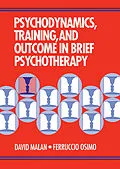Psychodynamics, Training, and Outcome in Brief Psychotherapy provides information pertinent to the fundamental aspects of dynamic psychotherapy. This book discusses the selection criteria, the principles of therapeutic methods, and the factors leading to therapeutic effects in psychotherapy. Organized into five parts encompassing 37 chapters, this book begins with an overview of the influence of research on clinical practice. This text then examines the evidences showing that most of the improvements were in fact due to therapy. Other chapters summarize the essential characteristics of the methods used with the patients in various case studies. This book discusses as well the concept of the triangle of conflict, which refers to one of the cornerstones of psychodynamic theory. The final chapter deals with the advantages of a psychotherapeutic clinic to certain kind of patients who can be greatly helped in a relatively short time. This book is a valuable resource for psychotherapists, psychiatrists, psychologists, and social workers.
Inhalt
What this book is about
Acknowledgements
Part One Introduction to the Present Study
1 Beginning at the end
The Nurse Mourning her Fiancé
The Girl and the Mountain Tarn
The Miner"s Daughter
The Borderline Graduate Clerk
The Librarian who Sought Suffering
Conclusion
2 The present study: background, aims, methods
Balint"s Workshop
Malan"s Brief Psychotherapy Workshop
Previous follow-up studies at the Tavistock Clinic
Assessing outcome in previous follow-up studies
Method of working in the present study
Aims and characteristics of the present study
Previous work by other authors
The work of Davanloo
3 Measuring outcome
Introduction
The Sculptress with Nightmares
Scoring
The scoring of "false solutions"
Patients who are worse
Conclusion
4 Overview of the present study and its results
Introduction
The return rate
Eligibility for the study
Over-all results
The ages of patients in the study
Therapeutic aims
Patients who had subsequent treatment
Another moderately good result in an ineligible patient
Definition and scientific status of the present study
5 The therapists
Comment
6 Therapeutic technique and the two therapeutic triangles
The focal technique and focal patients
The two therapeutic triangles
Part Two Clinical Material
7 The conservative and radical techniques: two patients with favourable outcome
Introduction
Notes on the case histories
The Pacifist Conductor
The Sculptress with Nightmares
Discussion
8 Two further patients with favourable outcome
The Nurse Mourning her Fiancé
The Librarian who Sought Suffering
9 Two male patients with oedipal problems
Introduction
The Car Battery Man
The Betrayed Son
Discussion
10 A woman patient with oedipal problems
The Girl and the Mountain Tarn
11 The seven "best" cases, discussion
Total resolution"
Total resolution and the rest of the sample
Similarities within the sample
Relations with the opposite sex
12 False solutions: I. general. II. two patients with relatively adaptive false solutions
Introduction
False solutions: General
The Rebellious Script Writer
The Concert-goer in an Acute Panic
13 False solutions: III. three patients with less adaptive false solutions. IV. general discussion
The Hypomanic Advertising Executive
The Secretary in a State of Nirvana
The Self-driving Physicist
General discussion of false solutions
14 Two women who showed limited improvements
The Allergic Receptionist
Mother, or Teenage Daughter?
15 Patients who showed minimal improvements
The Acting-out Accounts Clerk
The Actress with Elocution Problems
The Miner"s Daughter
16 Patients who showed no improvement
The Anorexic Museum Assistant
The Psychiatric Nurse with Attacks of Rage
17 Discussion of the five patients who showed minimal or no improvement
18 Patients who were worse: I. three patients who were wrongly diagnosed at initial assessment
The Girl with Eye Problems
The Borderline Graduate Clerk
The Robot Man
19 Patients who were worse: IL a patient who ought to have given a favourable outcome
The Victimised Telephonist
20 A calculated risk ending in catastrophe
The Acutely Suicidal Receptionist
21 The five patients who were worse: discussion
Part Three Types of Changes Found at Follow-up
22 Types of change: general
Introduction
Overview
Discussion of Table 22.1
23 Emotional freeing
24 Resolution of maladaptive behaviour patterns
25 The ability to "be oneself
Conclusion
26 Symptoms
Discussion
27 Relations with the opposite sex: I. clinical material
Introduction
Clinical material
28 Relations with the opposite sex: II. problems of commitment
29 Problems of aggression and self-assertion: I. general
Introduction: maladaptive and adaptive forms of aggression The Determined Mother
The concept of constructive self-assertion
Constructive self-assertion in the present series
30 Problems of aggression and self-assertion: II. clinical material
31 Problems of aggression and self-assertion: III. discussion
Comparison between problems of self-assertion and problems with the opposite sex
Classification of problems over aggression
The causes of problems over aggression
Comments on Table 31.1
Improvements that occurred during therapy
"Subjective" and "objective" evidence
Part Four Research Results
32 Therapeutic effects during therapy
Comment
33 Can the improvements be attributed to therapy?
Introduction: the nature of the evidence
Patients in whom the improvements persisted at follow-up
Additional evidence from improvements that did not persist at follow-up
Comment
Conclusion
34 Selection criteria
Introduction
The evidence on the four criteria
The four criteria, conclusion
35 Further research results
Further disproof of the conservative view of brief psychotherapy
Types of patient treated and focus used
Transference
Therapeutic results
Two fresh observations from the present work
The possibility of "multi-focal" therapy
Brief therapy by trainees
Part Five The Value of the Work
36 The practical and theoretical value of the work: I. for trainees, supervisors, and psychotherapists in general
Introduction
Trainees, supervisors, and other therapists
Initial assessment
Psychopathology
Technique
Material and events of therapy
Conclusion
37 The practical value of the work: II. for psychotherapeutic clinics and III for patients
Psychotherapeutic clinics
Patients
The relevance to the position of brief psychotherapy in general
The present work in the context of the work of Davanloo
References
Index
